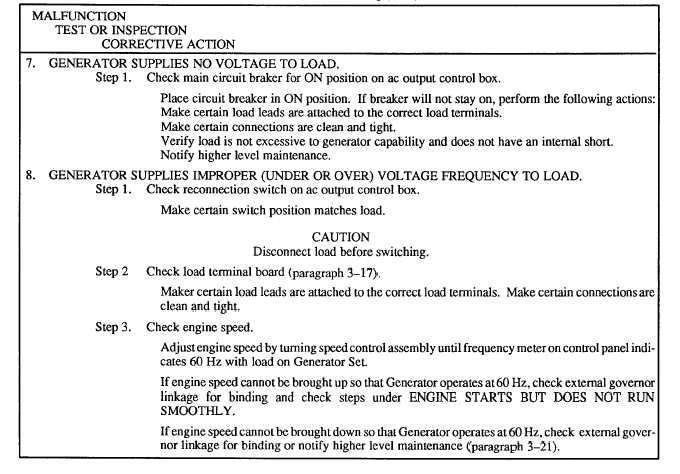warning
paragraph 3-17
paragraph 3-21
TM 5-6115-585-12
NAVFAC P-8-623-12
TO-35C2-3-455-1
TM-05684C/05685B-12
Table 3–3. Troubleshooting (Cont)
3-11. BATTERY ASSEMBLY.
a. Inspect (see figure 3–2). On generators equipped
with acoustic suppression (ASK), remove batteries access
door.
(1) Inspect battery cable terminal connectors (2),
(10) and (11) for corrosion, deterioration, or physical
damage. Inspect battery terminal covers (12) for proper
installation and physical condition. Replace if cracked, split
or tom.
(2) Inspect cables (1), (3) and (4)) for breaks,
damage and deteriorated insulation.
(3) Inspect battery top frames (5), bottom frame
(12), and tray (13) for corrosion or physical damage. Check
to see that batteries are held securely in place and that all
attaching hardware nut (7), washer (8), screw (14), washer
(15) and bolt (9) are securely in place.
Battery electrolyte can cause severe bums
to the skin. Always flush exposed parts of
the skin with water as quickly as possible.
3 - 8
Change 9
The 6TN and 6TL batteries can be mixed or matched.
However, maintenance–free batteries cannot be mixed or
matched with military batteries. The 6TN and or the 6TL
batteries will perform properly in hot weather as long as
electrolyte levels are carefully monitored. If the electrolyte
expands and causes the level to rise, some fluid must be
removed. If the level becomes too low due to evaporation,
distilled water may be used to obtain the proper level. A
good grade of drinking water (excluding mineral waters)
may be used if distilled water is not available.
Electrolyte
(NSNS
6810-00-249-9354
and
6810-00-843-1640) have a specific gravity of 1.280 and
should be used in these batteries. Do NOT adjust the
electrolyte in wet batteries to a lower specific gravity.
(4) Inspect battery (6) for leaks or cracks. Check
top of battery and battery caps for cleanliness. Check battery
electrolyte (liquid) level.
Level
s h o u l d be

